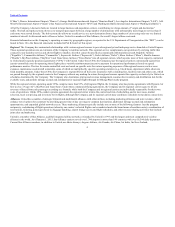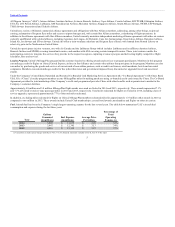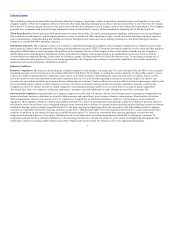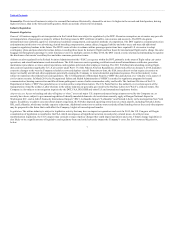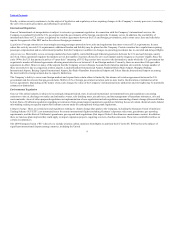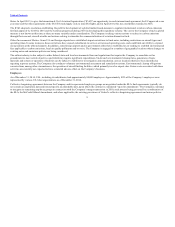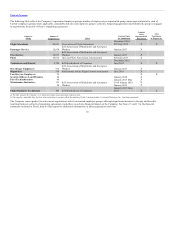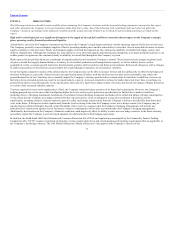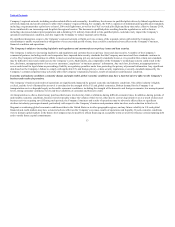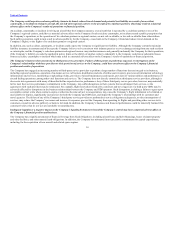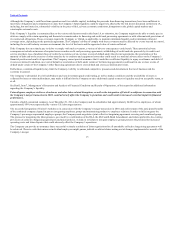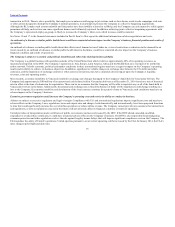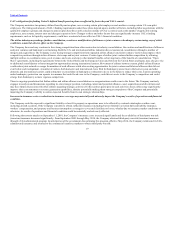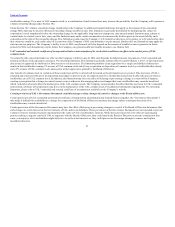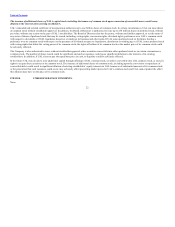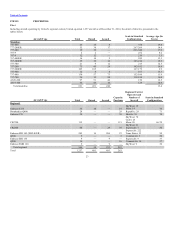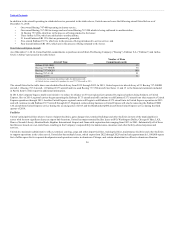United Airlines 2014 Annual Report Download - page 14
Download and view the complete annual report
Please find page 14 of the 2014 United Airlines annual report below. You can navigate through the pages in the report by either clicking on the pages listed below, or by using the keyword search tool below to find specific information within the annual report.
Table of Contents
The Company could experience adverse publicity, harm to its brand, reduced travel demand and potential tort liability as a result of an accident,
catastrophe, or incident involving its aircraft, the aircraft of its regional carriers or the aircraft of its codeshare partners, which may result in a material
adverse effect on the Company’s results of operations or financial position.
An accident, catastrophe, or incident involving an aircraft that the Company operates, or an aircraft that is operated by a codeshare partner or one of the
Company’s regional carriers, could have a material adverse effect on the Company if such accident, catastrophe, or incident created a public perception that
the Company’s operations, or the operations of its codeshare partners or regional carriers, are not safe or reliable, or less safe or reliable than other airlines.
Such public perception could in turn result in adverse publicity for the Company, cause harm to the Company’s brand and reduce travel demand on the
Company’s flights, or the flights of its codeshare partners or regional carriers.
In addition, any such accident, catastrophe, or incident could expose the Company to significant tort liability. Although the Company currently maintains
liability insurance in amounts and of the type the Company believes to be consistent with industry practice to cover damages arising from any such accident
or catastrophe, and the Company’s codeshare partners and regional carriers carry similar insurance and generally indemnify the Company for their operations,
if the Company’s liability exceeds the applicable policy limits or the ability of another carrier to indemnify it, the Company could incur substantial losses
from an accident, catastrophe or incident which may result in a material adverse effect on the Company’s results of operations or financial position.
The Company’s business relies extensively on third-party service providers. Failure of these parties to perform as expected, or interruptions in the
Company’s relationships with these providers or their provision of services to the Company, could have an adverse effect on the Company’s financial
position and results of operations.
The Company has engaged an increasing number of third-party service providers to perform a large number of functions that are integral to its business,
including regional operations, operation of customer service call centers, distribution and sale of airline seat inventory, provision of information technology
infrastructure and services, transmitting or uploading of data, provision of aircraft maintenance and repairs, provision of various utilities and performance of
aircraft fueling operations, among other vital functions and services. The Company does not directly control these third-party service providers, although it
does enter into agreements with many of them that define expected service performance. Any of these third-party service providers, however, may materially
fail to meet their service performance commitments to the Company, may suffer disruptions to their systems that could impact their services, or the
agreements with such providers may be terminated. For example, flight reservations booked by customers and travel agencies via third-party GDSs may be
adversely affected by disruptions in the business relationships between the Company and GDS operators. Such disruptions, including a failure to agree upon
acceptable contract terms when contracts expire or otherwise become subject to renegotiation, may cause the Company’s flight information to be limited or
unavailable for display, significantly increase fees for both the Company and GDS users, and impair the Company’s relationships with its customers and
travel agencies. The failure of any of the Company’s third-party service providers to perform their service obligations adequately, or other interruptions of
services, may reduce the Company’s revenues and increase its expenses, prevent the Company from operating its flights and providing other services to its
customers or result in adverse publicity or harm to its brand. In addition, the Company’s business and financial performance could be materially harmed if its
customers believe that its services are unreliable or unsatisfactory.
Inadequate liquidity or a negative impact on the Company’s liquidity from factors beyond the Company’s control may have a material adverse effect on
the Company’s financial position and business.
The Company has a significant amount of financial leverage from fixed obligations, including aircraft lease and debt financings, leases of airport property
and other facilities, and other material cash obligations. In addition, the Company has substantial non-cancelable commitments for capital expenditures,
including for the acquisition of new aircraft and related spare engines.
14


